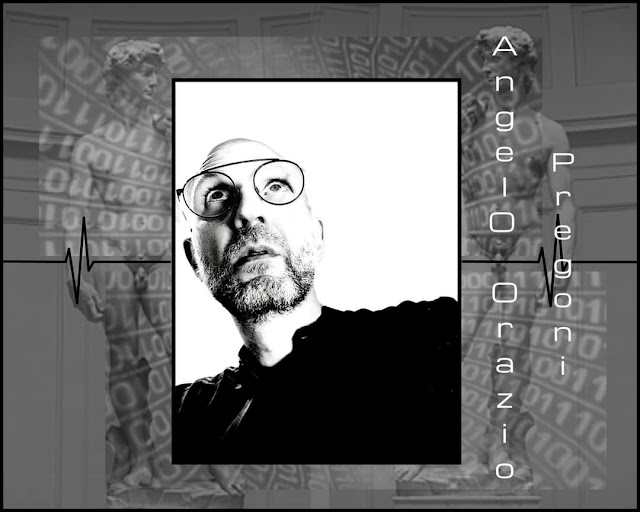Gender squint: Angelo Orazio Pregoni and the exception, as a celebration of life
Asymmetry is inherent in nature, so the question "Does the exception confirm the rule of opposing is the opposite?" by Primo Levi makes one reflect. In Pregoni’s works stands out this marked squint, which becomes... let’s see today what this showy defect means for the artist.
Edited by Maria Marchese
" ... as he was, incapable for ... "
(the comma with a colon function)
Before the worst happens
Angelo Orazio Pregoni
With religious respect, I steal a sentence, from 'Before the worst happens', by Angelo Orazio Pregoni I figure it, then, on paper and in my mind, as an 'aside'. I use it, then, and on paper and in my mind, as an 'engraving', to penetrate into an experiential 'smarginatura', which is a laceration of correspondence and calculation, and constitutes the tearing of the socially, historically redacted, and, therefore, accepted page. That particular use of punctuation is only the acme of an asymmetry, peculiar to the author's personality, that subverts the peaceful status quo: the infinitesimal detail, d'emblèe, in fact, seizes the edge and draws it, into an apparent dissonance. In that diastema, the pianist's fingers slide, simultaneously pressing two adjacent keys, emitting a 'guttural wail', as the gaze perceives that sudden slip. An imaginary bell then rings: is it an alarm?
"Dring! " ... in fact, it is an alarm clock, sounding the moment of emergence from hibernation. At that precise instant, Angelo Orazio Pregoni does not break the dream, 'sed educat' the individual to tread an eden or a dear fìo, perfumed by a surreal quotidian so biting and, at the same time, so profound as to destabilise. From there, the next step is escape or, on the contrary, fascination; most of the time, the unusual repels in favour of certainty, in other cases, it bestows 'extra-ordinary' experiences.
"The pianist's fingers" seem to slip out of control, even in his canvases.
The fallen accent, like an angelic creature, vanished from Paradise, a potential Fool, therefore, genius or demon, a sinful nail, lacquered red, etching the pure ivory flesh, in Pregoni's works is, by him, indoctrinated, between the brackets, guarding that marked deformity of the eyes.
There are faults that, knowing how to use them well, make a better figure than virtues.
The artist places the impertinent comma, between the eyeballs, in every single face, and it, threadlike and curved, insinuates itself there and emphasises, with equal, effective subtlety, the shattering of previous, pre-packaged, preconceived realities.
Angelo Orazio Pregoni illuminates, in this way, the exception. But does the exception confirm the rule or make it dubious?
Pasteur, in 1948, while studying the properties of a compound well known to oenologists, discovered chirality. Then, in quick succession, the Russian Aleksandr Michajlovi Butlerov, Friedrich August Kekul von Stradonitz, Jacobus van't Hoff, Joseph Le Bel, Emanuele Paternò... up to Giulio Natta probed unexplored terrain, mixing molecules, and came to an unexpected conclusion: nature makes choices, real breaks in symmetry.
Botticelli's hand conceals the two precious 'gems' of Venus and they seduce the atmosphere and the whole world; Venus' squinting is a form of chirality. The work 'Cada_veri' , the entire spicilegio of the 'Gender' series as well as the new 'Ethnicity' series affirm their 'heterogloss dignity', with that common denominator: a grainy, full sphere and a more timidly unfolded one pulverise 'the track', the straight path, 'so that the individual has the exquisite possibility of derailing, between anagogic virtues of a virile feminine and a mulieval child, where the concept of opposite is antithetical to the sacredness of life. The unconscious rituality itself, with which the artist's hand fills the forms with graces and sins of the 'nascent presences', in a succession of touches and lunges, synopses and sign/tonal narratives... seems to reflect the symbiotic celebration of life together with dissimilarity: the gestural chaos, only superficially unknown, without any explanation leads to an apparition of 'unfinished meaning'.
While clear lineaments sanction the end of the work, then, an intimate and introspective journey begins, which goes beyond the figure: there, one enters, losing one's formal identity and changing, then, into stateless and erratic privilege, through adumbrated cognitive soils. That unusual gaze reconciles and the presence of the self and the alter, celebrating a tribal dance, as tribal, primordial is the technical/compositional alphabet of the Genoese artist, a bestowal of an indomitable cognitive speculation.
When Emmy Noether, probably the greatest mathematician who ever lived, in 1918, elaborated the theorem establishing that in correspondence to every continuous symmetry of physical laws there is a law of conservation, and Steven Weinberg stated in his 1986 Dirac Memorial Lecture, 'At the deepest level, all we find are symmetries and responses to symmetries', stopping, in the midst of his own research, to think about the "deepest level, all we find are symmetries, and responses to symmetries", Primo Levi, pausing, humbly, on the threshold of the temple of the illuminati, in "Symmetry and Life" , contemplates how the hypothesis of the single event, of the one-off, is not pleasant and does not lead far, but, as it cannot be excluded, although fragile, it is constantly present in living matter, and is, perhaps, evolutionarily necessary, so that no spatial 'errors' occur in the construction of proteins. If one considers it as a metaphor, embracing wider values, one wonders, too, whether, for conservation, that 'trip' is, indeed, indispensable?
Angelo Orazio Pregoni certainly does not have this answer, but he does provide one, made up of 'terraquee' nuances that delineate the interstices of the psyche, the dark and remote corners of the soul, the perfect but hardly admissible truths... that, like faint whispers, graze the ears: then, the initial screeching, produced by the fingers, pressed, by deliberate mistake, by the composer Pregoni, have the strength to claim the truth of the same coin.




Commenti
Posta un commento